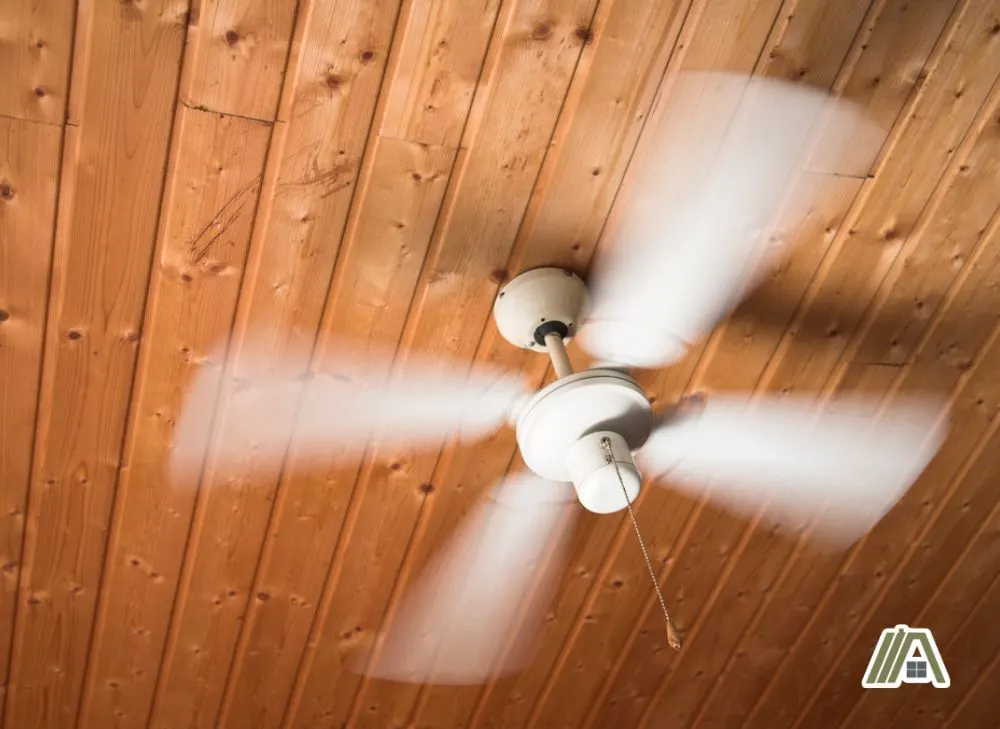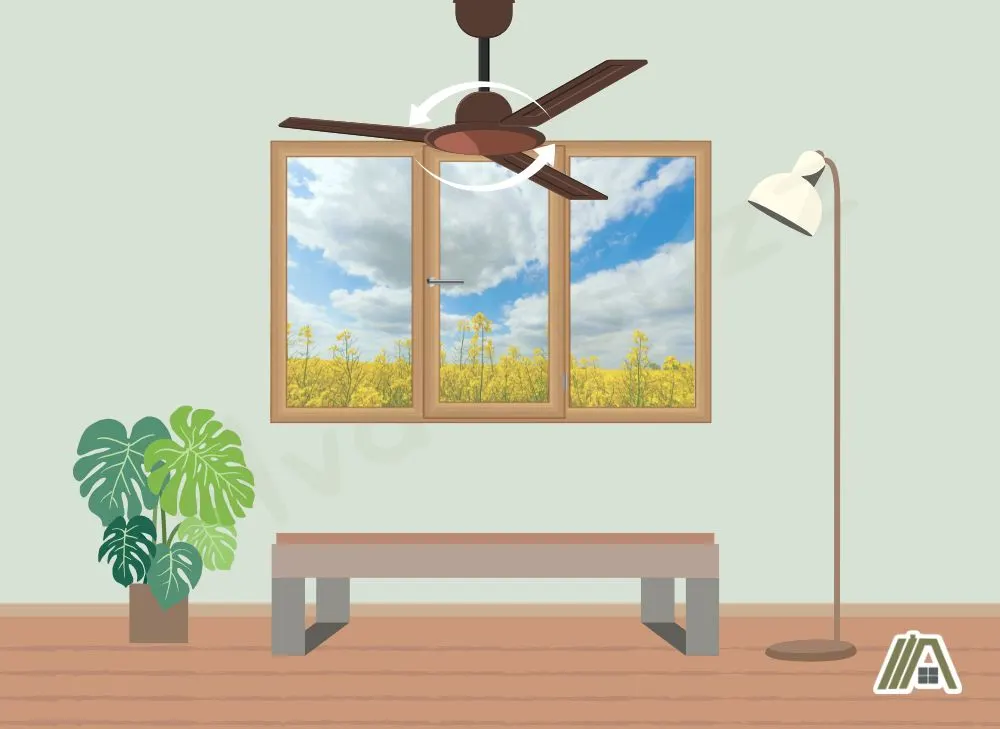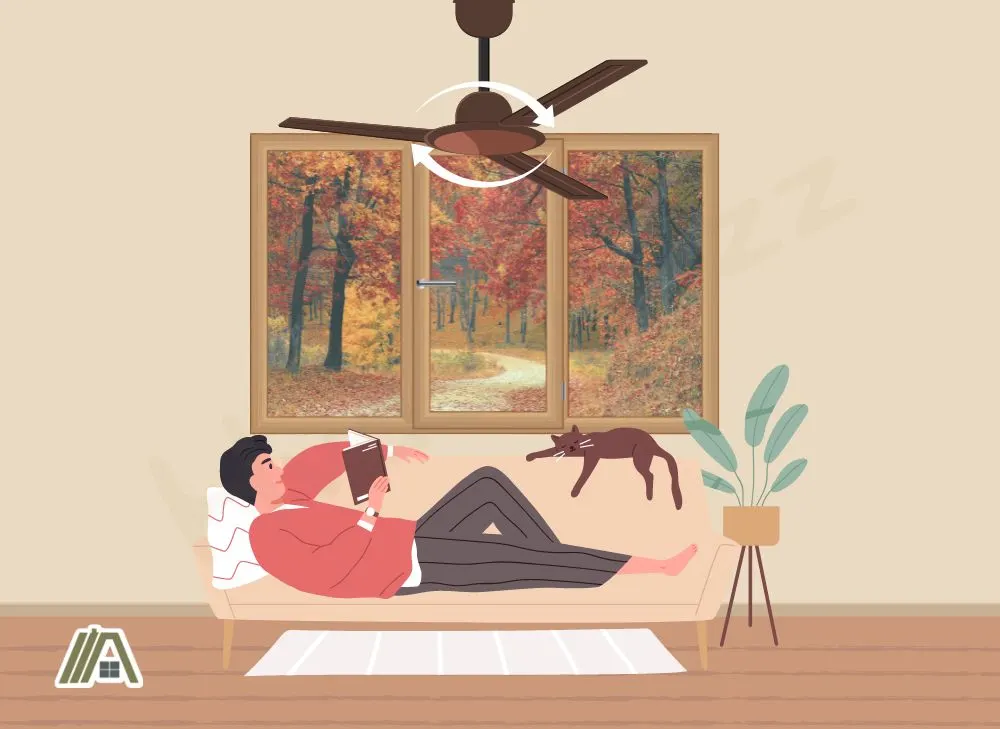Many modern ceiling fans are capable of turning in both directions. Many people know which way their fans should turn in summer and winter, but things get a little bit trickier when it comes to fall and spring since they are more “transitional” seasons.
Below, I set out which direction to choose when and why. I also discuss how using your fan can benefit you regardless of the season!

Ceiling fan direction in fall and spring depends more on the actual temperatures than the start of the season. Once the temperatures start dropping in fall, the fan can be set to rotate clockwise. When spring temperatures rise, set the fan to spin counterclockwise.
Why Change the Ceiling Fan’s Direction?
If you’re not familiar with the idea of reversible fans, you may be finding yourself a bit lost on what the purpose of changing your fan’s direction even is.

To explain briefly, when your fan rotates in one direction it creates an updraft, displacing warm air by the ceiling and moving it around the room.
The other direction is used to create a downdraft, which enables people to feel cooler through the use of a wind chill effect. This is the direction and use for ceiling fans that most people are familiar with.
Basically, if your fan is able to run in both directions, it can benefit you in colder weather too by increasing your comfort; it isn’t only able to cool you down in the summer!
Using Ceiling Fans in Fall & Spring
Before we really get into what direction your ceiling fan should be turning, I’d like to take this opportunity to say that changing your fan’s direction is a great opportunity to perform other maintenance on your fan!
While it’s generally recommended to clean the dust off of your fans at least once every other month, life can get in the way, and it can be hard to remember to clean something you don’t really see.
By using this change of direction as a reminder, you can ensure your fan is well cleaned at least twice yearly. Some fan models also require oiling, which may need doing once a year.
Which Way Should Ceiling Fans Turn in Spring?
While I’d like to give a specific answer for each season, the reality is that the climate and weather could be completely different from one place to another.
In some places spring may be cool and rainy, while spring may as well be part of a long summer in other places.
With that said, as a general recommendation, I would suggest setting your fan to turn counterclockwise, or to “summer mode” as you are likely to be experiencing warmer weather in spring.

Of course, rather than basing your fan’s direction purely on the seasons, you may choose to switch it based on temperature. As mentioned, climate can differ dramatically depending on where in the world you live.
With that being the case, you may simply start paying more attention once spring rolls around, but only actually set your fan to spin counterclockwise once the temperature begins feeling warm throughout the day.
Let’s get into why you’d want your fan to spin this way in warm weather.
Reasons to Use Your Ceiling Fan in Spring
While I mentioned that setting your fan to turn counterclockwise is preferred for spring (and summer, of course!) I didn’t quite explain why that is.
The primary benefit of having your fan spin in a counterclockwise direction is that this creates a downdraft. In other words, air is pushed down past you so that you can feel it, and creates a wind chill effect that makes you feel cooler.
A wind chill effect causes you to feel cooler by pushing cooler air past your skin and also pulling away the heat that your body produces. It also helps sweat to evaporate faster, and sweating is our body’s way of cooling us down naturally (evaporative cooling).
Of course, you should know that this means fans don’t actually cool down a room.
To sum it up, that’s the most obvious benefit of running a fan—it makes you feel cooler! But what not everyone considers is that this can come with a secondary benefit.
If you plan to spend most of your time in a room with a fan, you can set your thermostat several degrees higher than you normally would. Because the fan will help you feel cooler, you can save some extra money on your cooling. Some people save up to 40% on their AC costs!
Additionally, this puts less strain on your AC, which should give it a longer lifespan.
Which Way Should Ceiling Fans Turn in Fall?
Much like when it comes to spring, there is not a definitive answer I can give everyone on which way their fan should turn in fall.
Some parts of the world may experience very cool autumns, while others will continue to endure the heat of summer.
In general however, I would recommend setting your fan to turn clockwise (“winter mode”) in the fall, under the assumption that you are experiencing cooler weather.

Once again, you may choose to base the timing of your fan’s direction change on the actual temperature, not necessarily the start of the season. In that case, simply set your fan to turn clockwise once the weather begins feeling consistently cool.
Let’s talk about why this is the best option.
Reasons to Use Your Ceiling Fan in Fall
When your fan turns clockwise, it does the exact opposite of what it does when it turns counterclockwise. In other words, clockwise fan rotation creates an updraft rather than a downdraft.
This updraft pulls the cooler air near the floor up towards the ceiling, displacing the warm air that settles at higher elevations.
This warm air is pushed down the sides of the walls as it is displaced so that it ends up at an elevation where you can actually feel it!
Again, your fan doesn’t actually change the room’s temperature, regardless of direction. However, the fact that it can make the room feel warmer by redistributing the air is the primary reason for using your fan in cold weather.
Just like your ceiling fan can help you keep your AC costs down in summer, running your fan in a clockwise direction can allow you to keep your thermostat set a few degrees lower than you normally would once cold temperatures roll around.
This can allow you to save money on heating, since you won’t be sitting around in any cold pockets as long as your fan is running.
Sources
https://science.howstuffworks.com/question22.htm
https://www.bobvila.com/articles/ceiling-fan-direction/
https://www.gohermitage.com/blog/counterclockwise-fan-direction-for-cool-summer-savings/
https://www.hunker.com/13416378/how-to-oil-a-ceiling-fan
https://www.hunterfan.com/blogs/hunter-blog/ceiling-fan-direction-for-summer-and-winter
https://www.modernfanoutlet.com/blog/happy-spring-2019-aka-ceiling-fan-season.html
https://www.powermoves.com/2016/07/ceiling-fans-the-wind-chill-that-brings-down-your-power-bill/
https://www.sobieskiinc.com/blog/reverse-your-ceiling-fan-spring-comfort-and-savings/
